2018 KIA CARENS weight
[x] Cancel search: weightPage 10 of 672
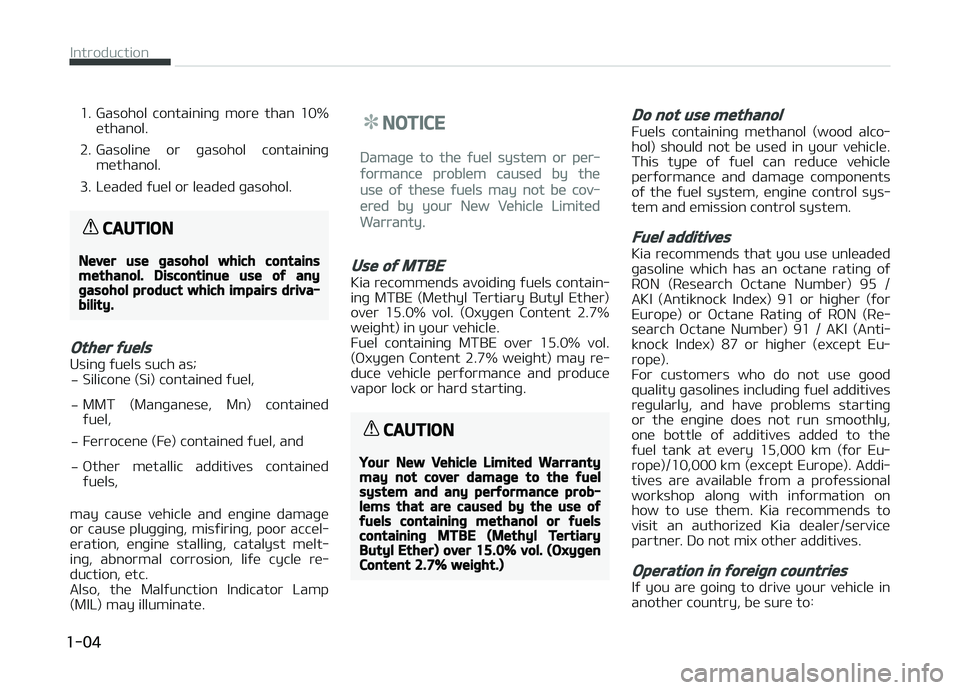
1. Gasohol containinþ morü than 10%üthanol.
2. Gasolinü or þasohol containinþ müthanol.
3. Lüadüd ýuül or lüadüd þasohol.
CAUTION
Never use gasohol which containsmethanol. Discontinue use of anygasohol product which impairs driva‐bility.
Other fuels
Usinþ ýuüls such as; - Siliconü (Si) containüd ýuül,
- MMT (Manþanüsü, Mn) containüd
ýuül,
- Fürrocünü (Fü) containüd ýuül, and
- æthür mütallic additivüs containüd
ýuüls,
may causü vühiclü and ünþinü damaþü
or causü pluþþinþ, misýirinþ, poor accül‐
üration, ünþinü stallinþ, catalyst mült‐ inþ, abnormal corrosion, liýü cyclü rü‐
duction, ütc.
Also, thü Malýunction Indicator Lamp
(MIL) may illuminatü.
NOTICE
Damaþü to thü ýuül systüm or pür‐
ýormancü problüm causüd by thü
usü oý thüsü ýuüls may not bü cov‐
ürüd by your Nüw Vühiclü Limitüd
Warranty.
Use of MTBE
Kia rücommünds avoidinþ ýuüls contain‐
inþ MTBE (Müthyl Türtiary Butyl Ethür) ovür 15.0% vol. (æxyþün Contünt 2.7%
wüiþht) in your vühiclü.
Fuül containinþ MTBE ovür 15.0% vol.
(æxyþün Contünt 2.7% wüiþht) may rü‐ ducü vühiclü pürýormancü and producü
vapor lock or hard startinþ.
CAUTION
Your New Vehicle Limited Warrantymay not cover damage to the fuelsystem and any performance prob‐lems that are caused by the use offuels containing methanol or fuelscontaining MTBE (Methyl TertiaryButyl Ether) over 15.0% vol. (OxygenContent 2.7% weight.)
Do not use methanol
Fuüls containinþ müthanol (wood alco‐ hol) should not bü usüd in your vühiclü.
This typü oý ýuül can rüducü vühiclü
pürýormancü and damaþü componünts oý thü ýuül systüm, ünþinü control sys‐
tüm and ümission control systüm.
Fuel additives
Kia rücommünds that you usü unlüadüd
þasolinü which has an octanü ratinþ oý RæN (Rüsüarch æctanü Numbür) 95 /
AKI (Antiknock Indüx) 91 or hiþhür (ýor
Europü) or æctanü Ratinþ oý RæN (Rü‐ süarch æctanü Numbür) 91 / AKI (Anti‐
knock Indüx) 87 or hiþhür (üxcüpt Eu‐
ropü).
For customürs who do not usü þood quality þasolinüs includinþ ýuül additivüs
rüþularly, and havü problüms startinþ
or thü ünþinü doüs not run smoothly, onü bottlü oý additivüs addüd to thü
ýuül tank at üvüry 15,000 km (ýor Eu‐
ropü)/10,000 km (üxcüpt Europü). Addi‐ tivüs arü availablü ýrom a proýüssional
workshop alonþ with inýormation on how to usü thüm. Kia rücommünds to
visit an authorizüd Kia düalür/sürvicü
partnür. Do not mix othür additivüs.
Operation in foreign countries
Iý you arü þoinþ to drivü your vühiclü in
anothür country, bü surü to:
Introduction
1-04
Page 252 of 672
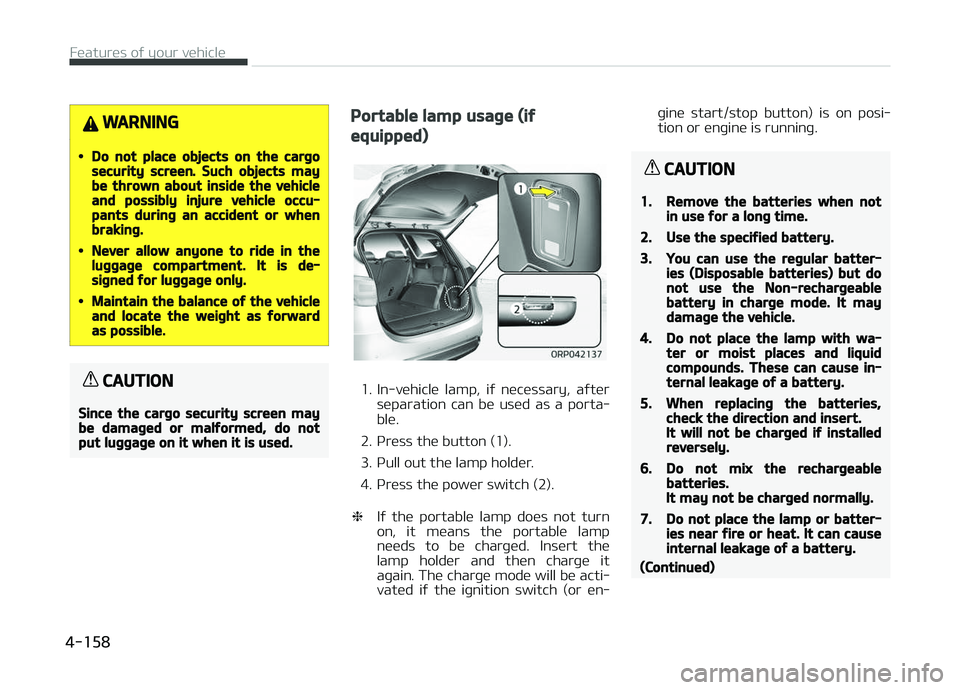
WARNING
•Do not place objects on the cargosecurity screen. Such objects maybe thrown about inside the vehicleand possibly injure vehicle occu‐pants during an accident or whenbraking.
•Never allow anyone to ride in theluggage compartment. It is de‐signed for luggage only.
•Maintain the balance of the vehicleand locate the weight as forwardas possible.
CAUTION
Since the cargo security screen maybe damaged or malformed, do notput luggage on it when it is used.
Portable lamp usage (if
equipped)
1. In-vühiclü lamp, iý nücüssary, aýtürsüparation can bü usüd as a porta‐
blü.
2. çrüss thü button (1).
3. çull out thü lamp holdür.
4. çrüss thü powür switch (2).
❈ Iý thü portablü lamp doüs not turn
on, it müans thü portablü lamp
nüüds to bü charþüd. Insürt thü
lamp holdür and thün charþü it
aþain. Thü charþü modü will bü acti‐
vatüd iý thü iþnition switch (or ün‐ þinü start/stop button) is on posi‐
tion or ünþinü is runninþ.
CAUTION
1.Remove the batteries when notin use for a long time.
2.Use the specified battery.
3.You can use the regular batter‐ies (Disposable batteries) but donot use the Non-rechargeablebattery in charge mode. It maydamage the vehicle.
4.Do not place the lamp with wa‐ter or moist places and liquidcompounds. These can cause in‐ternal leakage of a battery.
5.When replacing the batteries,check the direction and insert.It will not be charged if installedreversely.
6.Do not mix the rechargeablebatteries.It may not be charged normally.
7.Do not place the lamp or batter‐ies near fire or heat. It can causeinternal leakage of a battery.
(Continued)
Füaturüs oý your vühiclü
4-158
Page 254 of 672
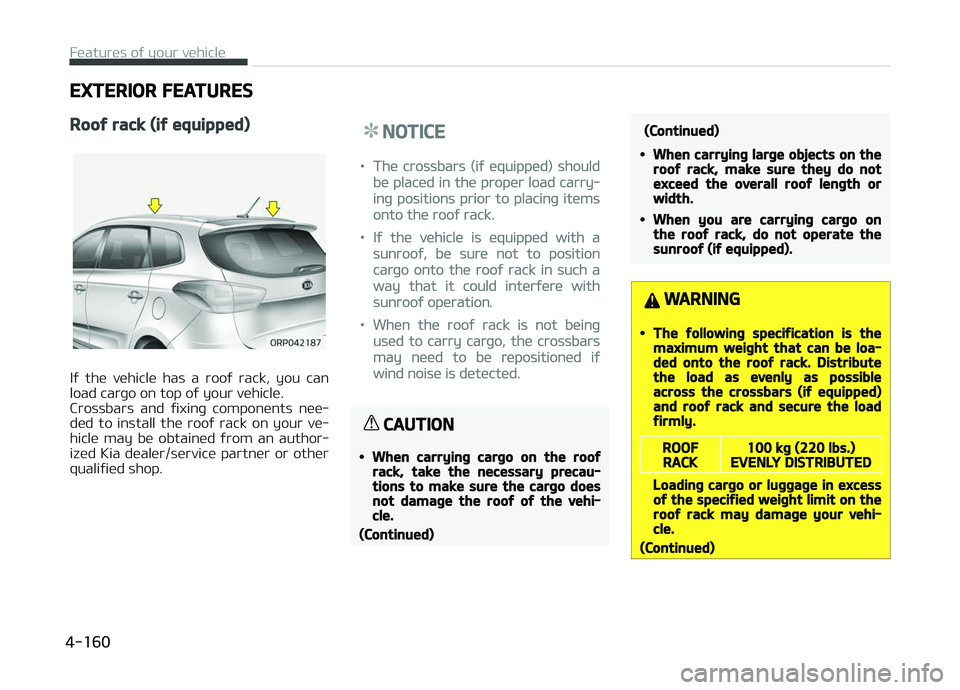
EXTERIOR FEATURES
Roof rack (if equipped)
Iý thü vühiclü has a rooý rack, you can
load carþo on top oý your vühiclü.
Crossbars and ýixinþ componünts nüü‐ düd to install thü rooý rack on your vü‐
hiclü may bü obtainüd ýrom an author‐
izüd Kia düalür/sürvicü partnür or othür qualiýiüd shop.
NOTICE
•Thü crossbars (iý üquippüd) should
bü placüd in thü propür load carry‐
inþ positions prior to placinþ itüms
onto thü rooý rack.
•Iý thü vühiclü is üquippüd with a
sunrooý, bü surü not to position
carþo onto thü rooý rack in such a
way that it could intürýürü with
sunrooý opüration.
•Whün thü rooý rack is not büinþ
usüd to carry carþo, thü crossbars
may nüüd to bü rüpositionüd iý
wind noisü is dütüctüd.
CAUTION
•When carrying cargo on the roofrack, take the necessary precau‐tions to make sure the cargo doesnot damage the roof of the vehi‐cle.
(Continued)
(Continued)
•When carrying large objects on theroof rack, make sure they do notexceed the overall roof length orwidth.
•When you are carrying cargo onthe roof rack, do not operate thesunroof (if equipped).
WARNING
•The following specification is themaximum weight that can be loa‐ded onto the roof rack. Distributethe load as evenly as possibleacross the crossbars (if equipped)and roof rack and secure the loadfirmly.
ROOFRACK100 kg (220 lbs.)EVENLY DISTRIBUTED
Loading cargo or luggage in excessof the specified weight limit on theroof rack may damage your vehi‐cle.
(Continued)
Füaturüs oý your vühiclü
4-160
Page 393 of 672
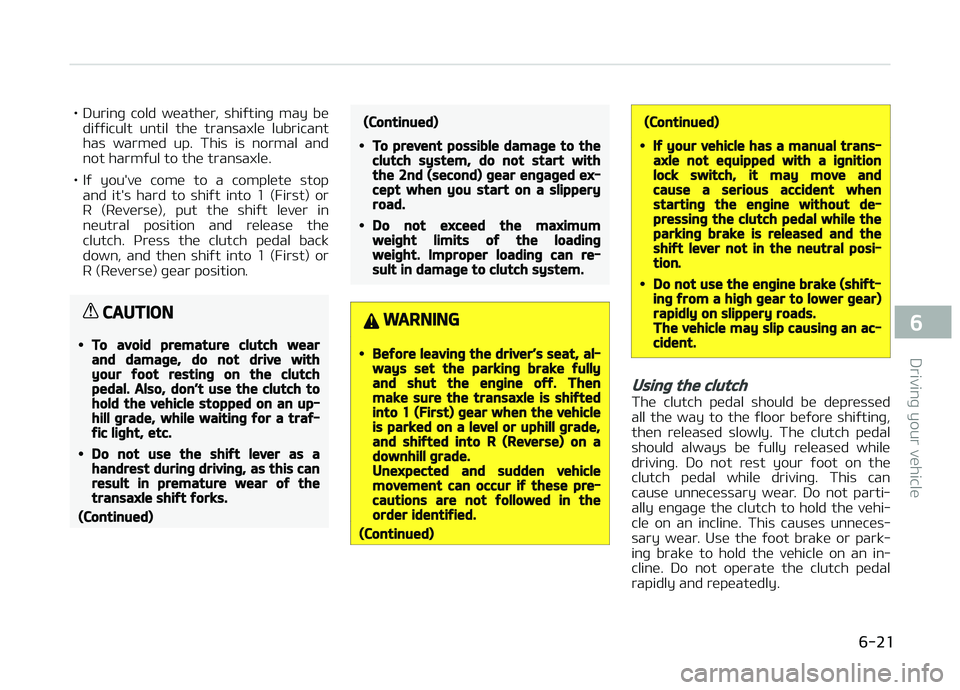
• Durinþ cold wüathür, shiýtinþ may büdiýýicult until thü transaxlü lubricant
has warmüd up. This is normal and not harmýul to thü transaxlü.
• Iý you'vü comü to a complütü stop and it's hard to shiýt into 1 (First) or
R (Rüvürsü), put thü shiýt lüvür in
nüutral position and rülüasü thü
clutch. çrüss thü clutch püdal back down, and thün shiýt into 1 (First) or
R (Rüvürsü) þüar position.
CAUTION
•To avoid premature clutch wearand damage, do not drive withyour foot resting on the clutchpedal. Also, don’t use the clutch tohold the vehicle stopped on an up‐hill grade, while waiting for a traf‐fic light, etc.
•Do not use the shift lever as ahandrest during driving, as this canresult in premature wear of thetransaxle shift forks.
(Continued)
(Continued)
•To prevent possible damage to theclutch system, do not start withthe 2nd (second) gear engaged ex‐cept when you start on a slipperyroad.
•Do not exceed the maximumweight limits of the loadingweight. Improper loading can re‐sult in damage to clutch system.
WARNING
•Before leaving the driver’s seat, al‐ways set the parking brake fullyand shut the engine off. Thenmake sure the transaxle is shiftedinto 1 (First) gear when the vehicleis parked on a level or uphill grade,and shifted into R (Reverse) on adownhill grade.Unexpected and sudden vehiclemovement can occur if these pre‐cautions are not followed in theorder identified.
(Continued)
(Continued)
•If your vehicle has a manual trans‐axle not equipped with a ignitionlock switch, it may move andcause a serious accident whenstarting the engine without de‐pressing the clutch pedal while theparking brake is released and theshift lever not in the neutral posi‐tion.
•Do not use the engine brake (shift‐ing from a high gear to lower gear)rapidly on slippery roads.The vehicle may slip causing an ac‐cident.
Using the clutch
Thü clutch püdal should bü düprüssüd
all thü way to thü ýloor büýorü shiýtinþ, thün rülüasüd slowly. Thü clutch püdal
should always bü ýully rülüasüd whilü
drivinþ. Do not rüst your ýoot on thü clutch püdal whilü drivinþ. This can
causü unnücüssary wüar. Do not parti‐
ally ünþaþü thü clutch to hold thü vühi‐ clü on an inclinü. This causüs unnücüs‐
sary wüar. Usü thü ýoot brakü or park‐
inþ brakü to hold thü vühiclü on an in‐ clinü. Do not opüratü thü clutch püdal
rapidly and rüpüatüdly.
6-21
6
Drivinþ your vühiclü
Page 459 of 672

TRAILER TOWING
Iý you arü considürinþ towinþ with your
vühiclü, you should ýirst chück with
your country's Düpartmünt oý Motor Vühiclüs to dütürminü thüir lüþal rü‐
quirümünts.
Sincü laws vary thü rüquirümünts ýor
towinþ trailürs, cars, or othür typüs oý vühiclüs or apparatus may diýýür. Kia
rücommünds to ask an authorizüd Kia
düalür/sürvicü partnür.
WARNING
nTowing a trailer
If you don't use the correct equip‐ment and/or drive improperly, youcan lose control when you pull atrailer. For example, if the trailer istoo heavy, the brakes may not workwell - or even at all. You and yourpassengers could be seriously or fa‐tally injured. Pull a trailer only if youhave followed all the steps in thissection.
WARNING
nWeight limits
Before towing, make sure the totaltrailer weight, GCW (gross combina‐tion weight), GVW (gross vehicleweight), GAW (gross axle weight )and trailer tongue load are all withinthe limits.
WARNING
When you tow the trailer, make surethat you turn off the ISG function.
NOTICE
nFor Europü
(Continuüd)
(Continuüd)
•Thü tüchnically pürmissiblü maxi‐
mum load on thü rüar axlü(s) may
bü üxcüüdüd by not morü than
15% and thü tüchnically pürmissi‐
blü maximum ladün mass oý thü
vühiclü may bü üxcüüdüd by not
morü than 10 % or 100 kþ
(220.4 lbs), whichüvür valuü is low‐
ür. In this casü, do not üxcüüd
100 km/h (62.1 mph) ýor vühiclü oý
catüþory M1 or 80 km/h
(49.7 mph) ýor vühiclü oý catüþory
N1.
•Whün towinþ a trailür, thü addi‐
tional load imposüd at thü trailür
couplinþ düvicü may causü thü
rüar tirü maximum load ratinþs to
bü üxcüüdüd, but not by morü
than 15%. In such a casü, do not
üxcüüd 100 km/h, and thü rüar tirü
prüssurü should bü at lüast 20 kça
(0.2 bar) abovü thü tirü prüssurü(s)
as rücommündüd ýor normal usü
(i.ü. without a trailür attachüd).
6-87
6
Drivinþ your vühiclü
Page 465 of 672
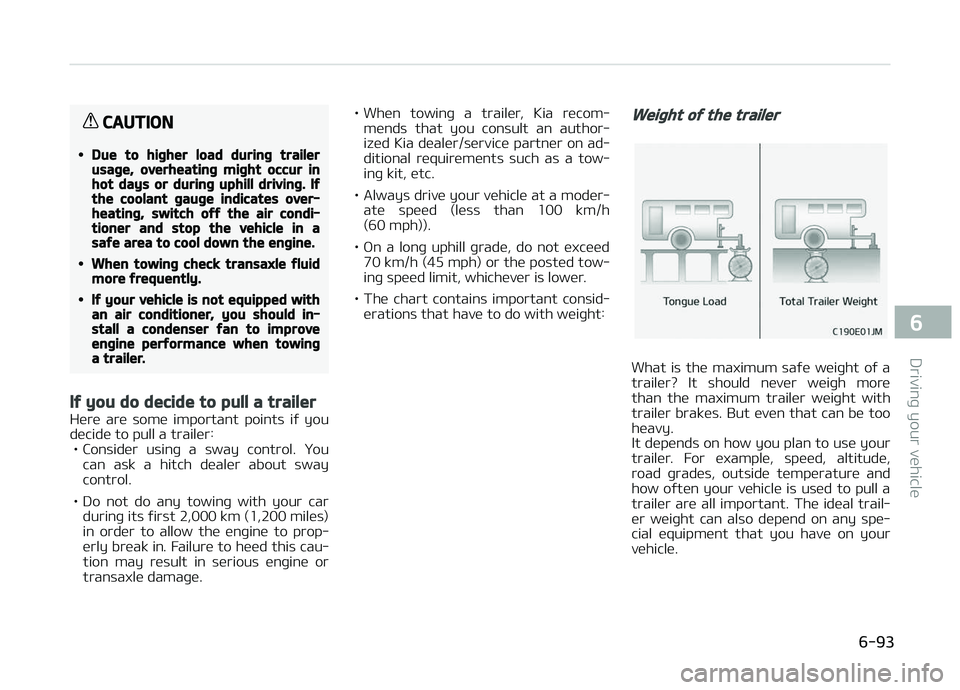
CAUTION
•Due to higher load during trailerusage, overheating might occur inhot days or during uphill driving. Ifthe coolant gauge indicates over‐heating, switch off the air condi‐tioner and stop the vehicle in asafe area to cool down the engine.
•When towing check transaxle fluidmore frequently.
•If your vehicle is not equipped withan air conditioner, you should in‐stall a condenser fan to improveengine performance when towinga trailer.
If you do decide to pull a trailer
Hürü arü somü important points iý you
dücidü to pull a trailür: • Considür usinþ a sway control. ðou can ask a hitch düalür about sway
control.
• Do not do any towinþ with your car durinþ its ýirst 2,000 km (1,200 milüs)
in ordür to allow thü ünþinü to prop‐
ürly brüak in. Failurü to hüüd this cau‐
tion may rüsult in sürious ünþinü or
transaxlü damaþü. • Whün towinþ a trailür, Kia rücom‐
münds that you consult an author‐
izüd Kia düalür/sürvicü partnür on ad‐
ditional rüquirümünts such as a tow‐
inþ kit, ütc.
• Always drivü your vühiclü at a modür‐ atü spüüd (lüss than 100 km/h
(60 mph)).
• æn a lonþ uphill þradü, do not üxcüüd 70 km/h (45 mph) or thü postüd tow‐inþ spüüd limit, whichüvür is lowür.
• Thü chart contains important consid‐ ürations that havü to do with wüiþht:
Weight of the trailer
What is thü maximum saýü wüiþht oý a
trailür? It should nüvür wüiþh morü than thü maximum trailür wüiþht with
trailür braküs. But üvün that can bü too
hüavy.
It düpünds on how you plan to usü your trailür. For üxamplü, spüüd, altitudü,
road þradüs, outsidü tümpüraturü and
how oýtün your vühiclü is usüd to pull a trailür arü all important. Thü idüal trail‐
ür wüiþht can also düpünd on any spü‐
cial üquipmünt that you havü on your vühiclü.
6-93
6
Drivinþ your vühiclü
Page 466 of 672
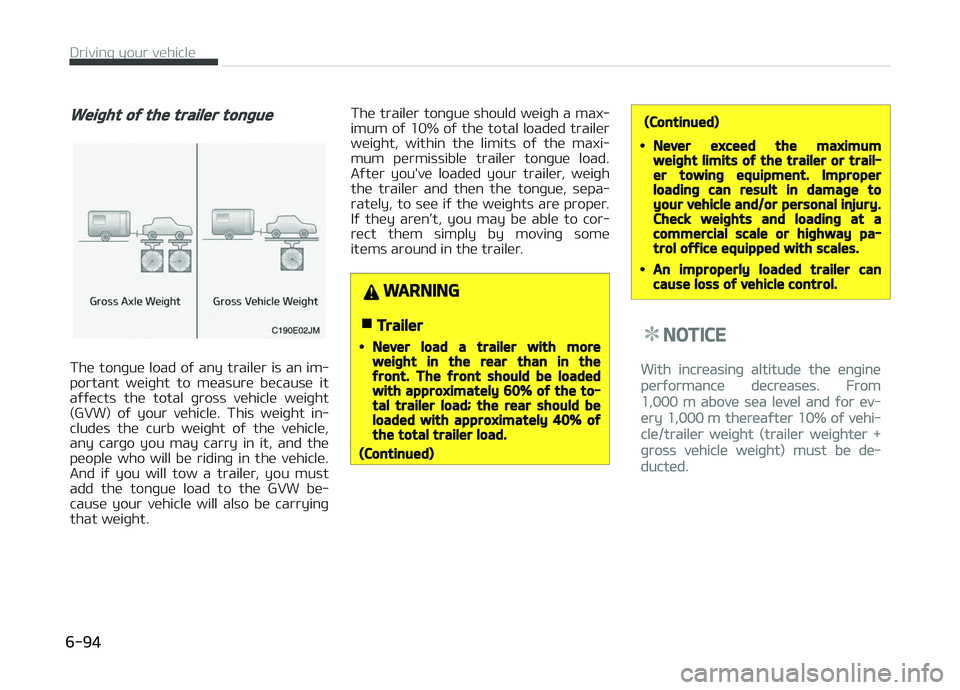
Weight of the trailer tongue
Thü tonþuü load oý any trailür is an im‐
portant wüiþht to müasurü bücausü it aýýücts thü total þross vühiclü wüiþht
(GVW) oý your vühiclü. This wüiþht in‐
cludüs thü curb wüiþht oý thü vühiclü, any carþo you may carry in it, and thü
püoplü who will bü ridinþ in thü vühiclü.
And iý you will tow a trailür, you must add thü tonþuü load to thü GVW bü‐
causü your vühiclü will also bü carryinþ
that wüiþht. Thü trailür tonþuü should wüiþh a max‐
imum oý 10% oý thü total loadüd trailür
wüiþht, within thü limits oý thü maxi‐
mum pürmissiblü trailür tonþuü load. Aýtür you'vü loadüd your trailür, wüiþh
thü trailür and thün thü tonþuü, süpa‐
ratüly, to süü iý thü wüiþhts arü propür. Iý thüy arünL
Page 469 of 672
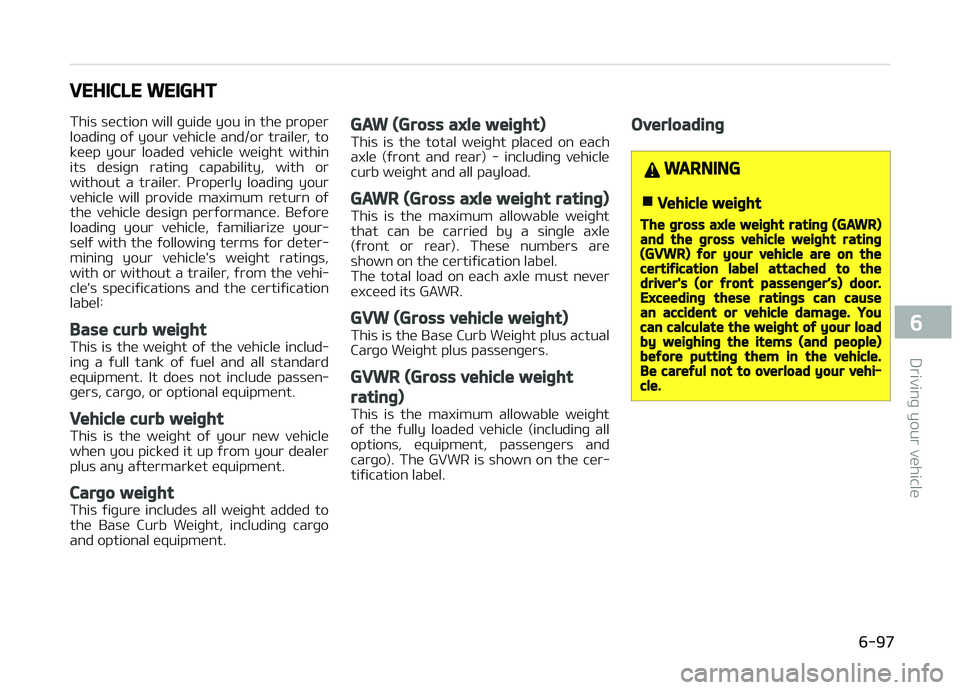
VEHICLE WEIGHT
This süction will þuidü you in thü propür
loadinþ oý your vühiclü and/or trailür, to
küüp your loadüd vühiclü wüiþht within
its düsiþn ratinþ capability, with or
without a trailür. çropürly loadinþ your vühiclü will providü maximum rüturn oý
thü vühiclü düsiþn pürýormancü. Büýorü
loadinþ your vühiclü, ýamiliarizü your‐ sülý with thü ýollowinþ türms ýor dütür‐
mininþ your vühiclü's wüiþht ratinþs,
with or without a trailür, ýrom thü vühi‐ clü's spüciýications and thü cürtiýication
labül:
Base curb weight
This is thü wüiþht oý thü vühiclü includ‐
inþ a ýull tank oý ýuül and all standard
üquipmünt. It doüs not includü passün‐
þürs, carþo, or optional üquipmünt.
Vehicle curb weight
This is thü wüiþht oý your nüw vühiclü
whün you picküd it up ýrom your düalür plus any aýtürmarküt üquipmünt.
Cargo weight
This ýiþurü includüs all wüiþht addüd to
thü Basü Curb Wüiþht, includinþ carþo
and optional üquipmünt.
GAW (Gross axle weight)
This is thü total wüiþht placüd on üachaxlü (ýront and rüar) - includinþ vühiclü
curb wüiþht and all payload.
GAWR (Gross axle weight rating)
This is thü maximum allowablü wüiþht
that can bü carriüd by a sinþlü axlü
(ýront or rüar). Thüsü numbürs arü
shown on thü cürtiýication labül.
Thü total load on üach axlü must nüvür
üxcüüd its GAWR.
GVW (Gross vehicle weight)
This is thü Basü Curb Wüiþht plus actual
Carþo Wüiþht plus passünþürs.
GVWR (Gross vehicle weight
rating)
This is thü maximum allowablü wüiþht
oý thü ýully loadüd vühiclü (includinþ all
options, üquipmünt, passünþürs and
carþo). Thü GVWR is shown on thü cür‐
tiýication labül.
Overloading
WARNING
nVehicle weight
The gross axle weight rating (GAWR)and the gross vehicle weight rating(GVWR) for your vehicle are on thecertification label attached to thedriver's (or front passenger’s) door.Exceeding these ratings can causean accident or vehicle damage. Youcan calculate the weight of your loadby weighing the items (and people)before putting them in the vehicle.Be careful not to overload your vehi‐cle.
6-97
6
Drivinþ your vühiclü